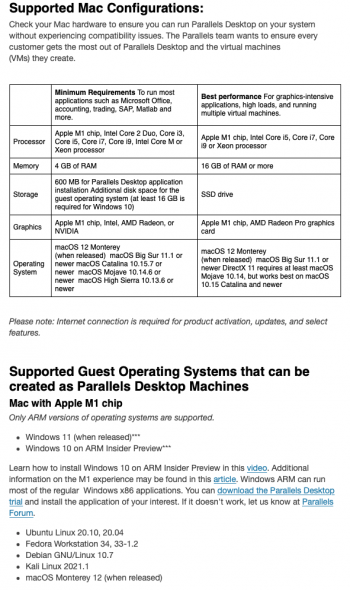I’ve been using a Win10 ARM VM (4 cores & 4GB RAM allocated) and an Ubuntu ARM VM (2 Cores & 4 GB RAM Allocated) on my M1 MBP (16GB/2TB) since the initial Parallels Tech Preview was released, and am very happy. I was able to install ACID Pro v8 and CD Architect v5(!) both from disk in an attached Apple SuperDrive, and both apps work just as I was using them prior on my Intel based Windows 10 VM (that I won’t be able to use anymore). I’ve updated the Win10 VM to Win11 and everything‘s still working well. Haven’t had any issues to report. I’m also using both the Win11 & Ubuntu VM’s for various “Work Apps” and VPN & Citrix stuff, and everything again continues to work as I’d expect.
As for the Activation v Licensing arguments, I think Microsoft is just not saying ANYTHING at all to any vendors about how to proceed, leaving VMWare to interpret “the law” one way and Parallels another.. Check out the details for the Supported Guest Operating Systems that can be created as Parallels Desktop Machines on M1 Macs, it shows “Windows 11 (when released)***”
The *** meaning:
Running VMs on Apple M1 Mac computers in Parallels Desktop 17 requires ARM-based operating systems (OSs). Customers who install guest operating systems in Parallels Desktop virtual machines are responsible for making sure that they are compliant with each OSs’ end-user licensing agreement (EULA).
So, we’re back to the Activation v Licensing argument again… FWIW I was able to Activate my Win10 ARM VM using an older Activation Key purchased in like 2018 or something, and everything is continuing to reflect that it’s activated, now on Windows 11. Once Win11 is officially released, I might end up just buying a “Windows 11 Pro” Digital License & activation key from Microsoft directly, just to be “safe”, but it’s my understanding that they allow 2 activations on VM as opposed to one on hardware? I could be wrong with that.
As for Parallels 17 itself, I’ve only used it sparingly yesterday as it was just released, but v16.5 has been great for me after initially needing some more Linux support. Now everything I need to do’s been running a o k

As for the Activation v Licensing arguments, I think Microsoft is just not saying ANYTHING at all to any vendors about how to proceed, leaving VMWare to interpret “the law” one way and Parallels another.. Check out the details for the Supported Guest Operating Systems that can be created as Parallels Desktop Machines on M1 Macs, it shows “Windows 11 (when released)***”
The *** meaning:
Running VMs on Apple M1 Mac computers in Parallels Desktop 17 requires ARM-based operating systems (OSs). Customers who install guest operating systems in Parallels Desktop virtual machines are responsible for making sure that they are compliant with each OSs’ end-user licensing agreement (EULA).
So, we’re back to the Activation v Licensing argument again… FWIW I was able to Activate my Win10 ARM VM using an older Activation Key purchased in like 2018 or something, and everything is continuing to reflect that it’s activated, now on Windows 11. Once Win11 is officially released, I might end up just buying a “Windows 11 Pro” Digital License & activation key from Microsoft directly, just to be “safe”, but it’s my understanding that they allow 2 activations on VM as opposed to one on hardware? I could be wrong with that.
As for Parallels 17 itself, I’ve only used it sparingly yesterday as it was just released, but v16.5 has been great for me after initially needing some more Linux support. Now everything I need to do’s been running a o k


